#Jose Alejandrino
Text
I plan on translating Rizal's satire
KATATAPOS KO LANG sa Life and Works of José Rizal course ko at sa isang banda ay naiinggit ako sa tatay kong tatlong beses itong kinuha. Nabitin ako! Hinayaan ako ng Rizal course na magiging madaldal about something that I'm passionate about, at na-challenge din akong mag-explore pa lalo.
Sa pag-e-explore na 'yun, napadpad ako sa collections ng wirtings ni Rizal, particularly Epistolario Rizalino at Jose Rizal National Centennial Commission (JRNCC) publications, and some other resources tulad ng La Senda del Sacrificio ni José Alejandrino (kung saan ni-recall ni Alejandrino 'yung time na sinabi ni Rizal na pinagsisihan niyang pinatay niya si Elias sa Noli me tangere).
Na-assign akong mag-report, along with two other groupmates, tungkol sa stay ni Rizal sa London at Paris at tungkol sa writings ni Rizal from around those times. Nababanggit lang talaga in passing sa mga discussion ang La Vision del Fray Rodriguez (Ang Pangitain ni Fray Rodriguez) at Por Teléfono (Sa Pamamagitan ng Telepono), mga satirical stories na sinulat ni Rizal bilang ganti sa mga prayleng kritiko ng Noli na sina José Rodriguez at Salvador Font.
Isiningit ko sa paghahanda ng report ang pag-skim sa mga kuwentong ito at na-fixate naman ako agad (because of course). Interesting ang premises ng dalawang kuwento. Sa La Vision, sinermunan ni San Agustin si Padre Rodriguez at pinarusahang magsulat ng nonsense habambuhay. I particularly like na isa sa reasons ng pagbaba ni San Agustin ay dahil kahiya-hiya na sa paningin ng ibang mga santo ang pinaggagagawa ng mga prayleng Agustino. Sa Por Teléfono naman, I love the sarcasm! May part sa may umpisa that goes like this: "Salamat sa perpektong pagkagawa sa telepono ay maririnig maging ang katahimikan sa komedor, at mababatid mula sa mga tunog ng pagnguya na maging ang pinakamatakaw na prayle ay hindi kumakai ng higit sa limang subo sa isang araw."
At the time, 'yung original Spanish pa lang ang nakita ko. May existing translations naman ng mga ito sa Filipino sa JNRCC publications, pero medyo luma na at sinusunod ang Spanish-style formatting na posibleng ikalito ng non-Spanish speaking readers. Gusto kong gumawa ng updated translations, para rin madali kong ma-share sa iba itong dalawang story na 'to. Hopefully, makapag-translate ako ng kahit isa sa dalawang ito habang sem break ko.
Gusto ko nga rin sanang gawan ang mga 'to ng komiks adaptation, pero siyempre, mas labor-intensive 'yun. Looking back at the content ng mga kuwento, tingin ko ay mas magandang gawing komiks ang La Vision—parang ang satisfying makita 'yung eksena kung saan pinalo ni San Agustin si Padre Rodriguez ng baston sa tiyan, hindi siya nakilala, kaya pinukol niya naman sa ulo at nabali ang baston dahil matigas ang ulo ng prayle. Literal na phone conversation lang at kaunting narration ang Por Teléfono, so I think this will stay as prose.
I'd really love for others to read these stories, sadyang (1) hindi lang ito accessible sa marami sa ngayonand (2) hindi lahat ay interested sa mga bagay-bagay na may kinalaan sa Philippine history. Hopefully, maging tulay itong plano ko para malagpasan kahit 'yung unang problema man lang.
4 notes
·
View notes
Text
Jeepney Phaseout: Eradication of Unique Filipino Commute Encounters
By: Camille Faith Alejandrino, Bedylyn Pacete, & Floriel Santos
March 25 2023 08:00 PM
After several decades of being a staple to Filipino roads and streets, the traditional mass transit is in danger of bidding its goodbye.
Bulakenyo regular commuters were unhappy now that the public transportation deemed to be the 'King of the Road' is at risk to be dispose as the Philippine government plans to phaseout traditional jeepneys in place for modern, and more expensive counterpart of it.
The history of jeepney goes way back after World War II ended in the country, when both Americans and Japanese left military purpose vehicles. Challenged by the outcome of the ruins of transportation from both rural and urban areas, ingenuity bloomed from Filipinos as they repurposed the vehicles into the jeepney that is known today.
It was not until the 1950s when jeepneys started hitting the streets and became a public mass transit used to transport multiple passengers from one route to another. Even after more than 60 decades, jeepney continues to reign as the king of the roads and of the ordinary Filipino commuters’ hearts — a substantial part of the local transportation culture.
It’s no wonder that plenty of Filipinos have their fair share of unique experiences while travelling by means of jeep, which is proven by the occurences of several jeepney stories and memes scattered around social media and chattered about by ardent or avid jeepney passengers.
From the family of Badjao with their unique accent that's exceptionally evident when they ask for donations from the passengers, seemingly possessed college students who are muttering details from their reviewers, group of gossiping friends, booming speakers blasting out remixed pop songs of the driver, and vendors who sell their products right inside the jeep, every day is indeed something that should be look forward by regular commuters as jeepneys never fail to introduce unique scenarios for its every ride.
Lora Fulleros, a college student, who only travels via jeep from San Jose Del Monte, Bulacan to her school, Bulacan State University, said that riding a jeepney is always a unique experience, especially compared with traveling using other public utility vehicles. “Kung paano kayo dalhin ni Kuyang Driver, ganun na rin yung mararanasan niyo kumpara sa bus na may kaniya-kaniya kayong upuan” she explained, describing how a person’s experience sitting on the narrow bench chairs, is basically the same as the other person sitting beside them.
Jeepneys are oftentimes cramped and scorching especially in a hot climate, particularly during rush hour, it's expected that the jeep will be filled of tired students and workers, that's why during the whole ride, everyone will feel the heavy energy inside the vehicle that will make them fall into silence, symphatize with the exhausted ones, the way people connect with one another inside the jeep is what makes every travel a unique experience.
It's never the same as the other modern vehicles, college student Rommel Dizo said. “Yung mami-miss mo talaga dun ay yung everytime magkakangitian kayo ng nasa harap mo. Kumbaga may mga moments wherein nakikinig ka sa mga conversations ng mga nasa harap mo o sa tabi mo.” Although he clarifies he is not a gossiper, “Kahit di ka naman nakikinig dun, naririnig mo and you get to realize na ganito pala sa PIlipinas, ganito pala kapag sumakay ka sa jeepney… you learn from others just by listening to their conversations sa loob ng jeep.” he meaningfully added.
Terms and slangs like “1-2-3” (a practice done in jeepneys wherein a passenger does not pay fare to an unsuspecting driver and runs away) have since then blossomed from the tongues of ardent jeepney commuters, along with the iconic phrase “para po” that is use to tell the driver to drop someone by a certain location – or the “bayad po”, which will be immediately follow if the passenger is seated on the far end from the driver’s seat, with “makikisuyo po” or “paki-abot po” to politely ask the person sitting very closely to them to hand their fare to the driver. These are distinct Filipino discourses that can be only authentically hear within the narrow, scorching steel chamber of a contraption Pinoys lovingly call jeep.
When asked whether he has done 1-2-3 before, Rommel humorously nodded his head and said yes, but it was unintentional according to him. “Pagod na pagod kasi ako galing sa school… hindi ko namalayan na hindi pa pala ‘ko nakapag-bayad kase nung pag-akyat ko ng jeep, bigla akong nagpahinga saglit. And then maya-maya, may mga group of friends na nakatingin sa akin, and then sobrang na curious ako, ‘Ano kaya reason kung bakit nakatingin sila sa akin?’ ‘Yun pala pagbaba ko sa jeep, ‘di pala ‘ko nakapag-bayad…” he said with a smile on his face while recalling the funny and embarrassing memory.
For Education major Gian Marie Santos, her most embarrassing moment was on a jeepney when she accidentally bumped her head on the vehicle’s ceiling. “Kadalasan nauuntog ako,” she admitted. “Kasi naka-heels ako so pagka [sa] dulo ka sasakay ng jeep, talagang siyempre yuyuko ka. Eh minsan pagka naman pababa [ng jeep], yun bang hindi mo akalain mababa yung ulo ng jeep kaya madalas akong nauuntog.” It's generally a very usual occurrence, given that a jeep’s entrance has always been so low and cramped that a passenger normally has to crouch to get in or out of the vehicle. Unfortunately for tall people, they do have a hard time getting in and out of a jeep, but seeing someone bumped their heads on the jeepney’s ceiling at least once in a while is part of the memorable experience.
“Yung jeepney kasi, part na ng ating culture. Hindi na ‘yan mawawala sa kasaysayan.” Troy Laderas, an office worker said. He said he’ll never have the same experiences he had on a traditional jeepney with the modernized ones. “Mas iba pa rin yung [traditional] jeepney kumpara sa mga bago ngayon… kase mas mura, at marami ka pang makakasalamuhang mga tao.” He further explains.
Traditional jeepneys are usually 11 meters long and 2.5 meters wide with long, lookout window-like windows on the side that is usually open for passengers to stick their hands out and feel the city or province breeze. “Sa jeepney, mararanasan mo pa yung hangin sa labas, yung lakas ng hangin, yung talagang guguluhin yung buhok mo gano'n. Iba pa rin, iba talaga.” Lora Fulleros' take on why jeepneys are unique.
Over the years, jeepney drivers have especially provide opportunities for local artists that is tasked to maintain the aesthetics of their vehicle, from its classic karatula font, and the paintings on its every parts, jeep is indeed not just a basic mode of transportation, but an art.
“Pag sinabi kasing jeepney, ang una nating maiisip, Pinoy talaga. Yung pinaka-unique dun siguro ay yung design… may iba-iba ding murals, or mga murals sa body ng jeep.” College student Marlon de Guia emphasized.
Mother and housewife Mary Zon Paranbita proudly proclaims that she has grown up with jeepney as her main mode of transportation. “Kasi ‘yan naman talaga kinamulatan natin – jeep naman diba? Bago pa man dumating yung mga bago ngayon na mga sasakyan, talagang yung jeep na talaga yung maaasahan na sasakyan. ‘Pag nawawala ‘yan, maglalakad ang mga tao…” she highlighted to emphasize the importance of jeep.
Jeepneys have grown to be a significant representation of Filipino culture; they have become one of the country's trademarks because of their uniqueness and as a vehicle that people can call their home. Jeepneys have pretty much become a part of every ordinary Filipinos’ daily lives, especially in most major cities and some provinces. “Kaluluwa na siya ng kultura natin.” as Rommel would put it.
“Kilala tayong mga Pilipino na pala-kaibigan. We are friendly and sa simpleng pagsakay mo sa jeep, naho-hone ‘yun eh. Kumbaga parang nabe-better mo yung sarili mo – halimbawa, may nag-abot ng [bayad] sayo, at sa simpleng ganung bagay, nagagawa mong makipag-converse sa ibang mga tao kahit sabihin mo [pa] sa sarili mo na introvert ka.” He added.
Alex Marciano, also a college student, shares the same sentiment and reiterates that jeepneys really are important as a cultural symbolism for Filipinos. “Jeepney kasi is, ‘dun kilala yung Philippines since before 'yun na yung type ng [transportation meron tayo] … ‘dun tayo nare-recognize eh.” She also shared her most memorable jeepney encounter, "One-time yung driver is nilibre niya kami ng mga friends ko nung wala siyang panukli, so sabi niya ayun libre na lang," she said, describing the little moment of her and her friends. Camaraderie is one Filipino character that jeepneys symbolize. It reflects the people from the Philippines' collectivist culture, resiliency, and optimism despite many challenges.
Now that the PUV is set to be dismantled, the respondents share the same sentiment and message to the legislators rolling out the phase out. “If ever man na may mga changes na gagawin regarding sa ating modern jeepney, sana hindi pa rin ma-phaseout yung [traditional] jeepney. If ever man na may babaguhin nga sa ating mga current na mga jeepneys, siguro magkakaroon lang ng mga innovations at improvement… dapat mas accessible siya especially sa mga Persons With Disability (PWDs).” Marlon suggested.
Rommel, on the other hand, urges the government to consider the masses before passing out a bill. He reiterated the government’s role to provide and pass something that is beneficial as well as necessary for the welfare of the people “Bigyan natin ng espasyo yung mga marhinalisadong sektor kase sila yung maapektuhan nito eh. Imagine 2 million yung cost ng isang modern jeepney tapos iiwan sa kanila yung responsibility na bumili ng bago when in fact, barya lang yung nagiging sahod nila.”
“Ang masasabi ko lang ay balikan natin yung pagkakakilanlan natin. Modernization is good but maganda pa rin sana tuwing magmo-modernize sila ng isang bagay, dapat damay tayong lahat na makararanas ng ginhawa hindi lang yung para sa iilan.” Lora Fulleros ended.
Jeep served as a home along the road for every passengers who have their own unique customs and identities, the way that the designed narrow space of a simple vehicle has the power to connect people who grew up from different environment supply the idea that it became a melting pot of cultures that shaped different stories from regular commuters, might it be fun, sad, or infuriating.
Standing against jeepney phaseout just not revolves around technical justifications, it's also a matter of cultural and sentimental value of the vehicle that regular Filipino commuters fear to never encounter again.
1 note
·
View note
Photo

General Jose Alejandrino’s Ilustrado days in Madrid gave him the nickname Miki.
M I K I (bihon)
31 notes
·
View notes
Photo


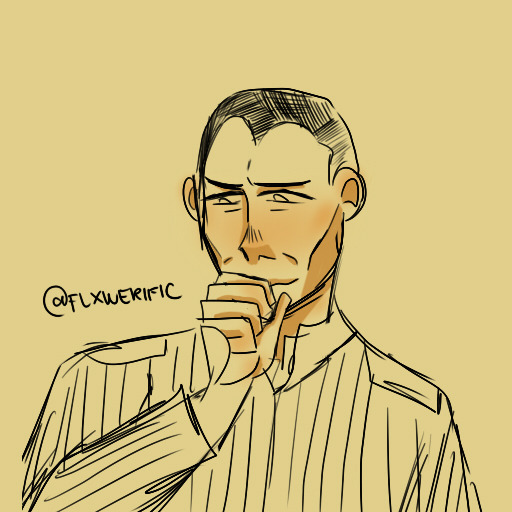



doodles from Twitter!
#heneral luna#heneral moon#goyo: ang batang heneral#joven hernando#marcelo h del pilar#jose alejandrino#manuel bernal#jose bernal#angel bernal#anghelito#andres bonifacio#gregoria oryang de jesus#doodles#sketches
17 notes
·
View notes
Photo
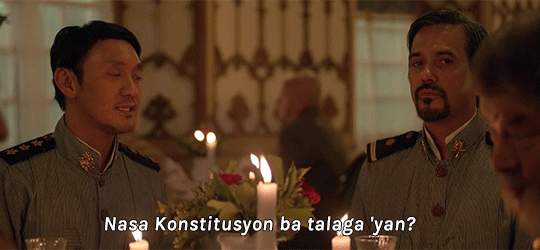
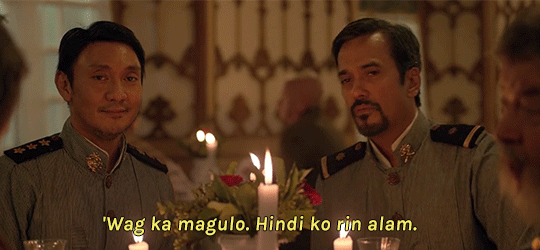
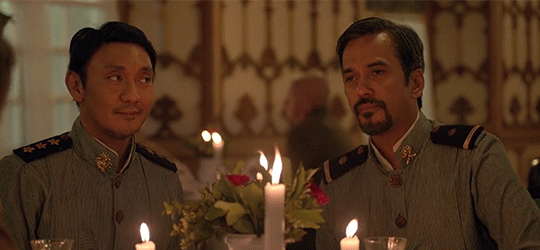
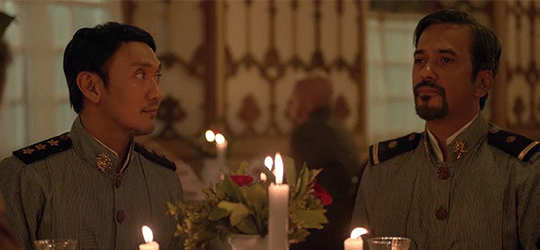
sass level: alejandrino
#akin#evaristo ortiz#jose alejandrino#alejortiz#goyo: ang batang heneral#goyo2018#heneral goon#heneral moon#bayaniserye#NINONGS#<333333#ortiz is shooketh
85 notes
·
View notes
Photo
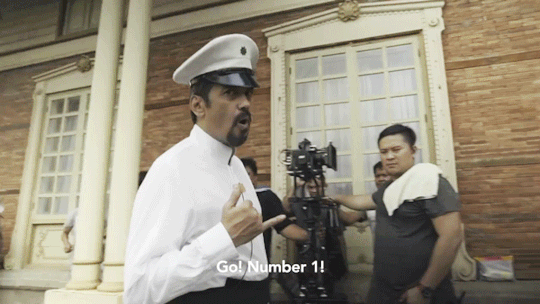
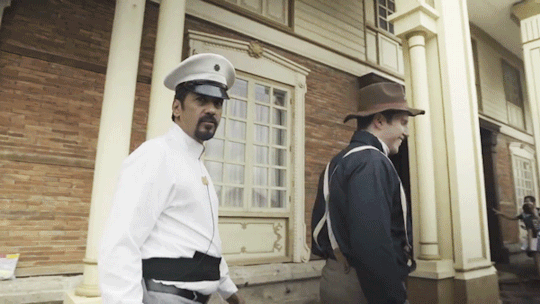
This is me every time someone asks me who's my favorite.
#GOYO#Goyo: Ang Batang Heneral#Jose Alejandrino#Alvin Anson#Bloopers#Goyo Bloopers#GOYO: Ang Batang Heneral Blooper Reel
16 notes
·
View notes
Photo
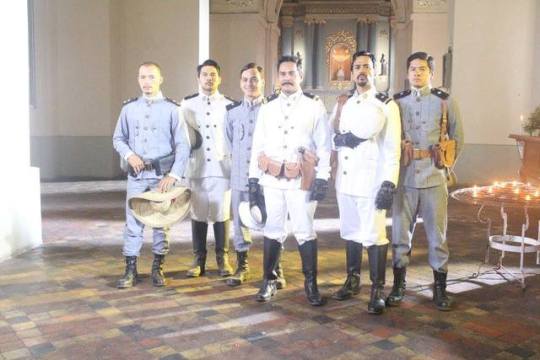
Class picture kasama ng adviser at division head
#Heneral Luna#Manuel Bernal#Paco Roman#Eduardo Rusca#Antonio Luna#Jose Alejandrino#Jose Bernal#HL bts
65 notes
·
View notes
Photo



Ang Pagbibinata ni Joven Hernando-Bernal
(alternately, The Life and Times of Jovito Hernando, Bernal Brother #3)
a fic by @toniongbuwan / @ipakomokoroman
with @sumbungero / @chinupacoroman
images by @dettsu / @bagyong-goyong
1,700 words of 20k+ | PG | Pacoven (One-sided), Paco Roman/Juliana Piqueras
chapter index: 1, 2, 3, 4, 5, 6, 7, 8, 9, 10, 11, 12, 13, 14, 15, 16
Chapter 16: “He already knows. ‘Pag dating mo kanina sabi ko sa kanya na kakaibiganin kita.”
December came, and along with it, José Alejandrino.
There was no word. One Saturday morning, a polite but insistent knock was heard on their gate. José looked up, annoyed. He was trying to plumb the mysteries of setting up the Christmas tree. Who knew it had so many teeny-tiny parts? He thought that it was just one big plastic tree that they kept in a box in the garage.
“Sino ‘yan?” he called out from the door.
“Does a Manuel Bernal live here?” and, in strangely accented Filipino. “Dito ba nakatira si Manuel Bernal?”
“Sino po kayo?” he asked. It was a tall, bearded man with salt-and-pepper hair, looking at odds in their neighborhood with his immaculately pressed polo shirt and slacks.
“Ikaw ba si José?” he asked suddenly “Si José Alejandrino ‘to.”
José looked closely and gave a startled laugh. “Ninong José? Ah! Sorry, sorry po.” he quickly went out to open the gate and ushered the visitor in. “Kelan po ba kayo dumating?” José pushed all the miscellaneous debris from random Christmas decorations on top of the coffee table to the side, to make the living room more presentable.
“Kahapon lang. It was a sudden thing. Family matters. I will stay here for several weeks.” he looked around “Si Joven? Nasaan siya?”
“Ah, sandali lang, tatawagin ko siya!” José said going towards the direction of the stairs, careful not to trip on a box of tinsel.
“Jovito? Jovito?” he knocked “Buksan mo, si Ninong José mo nandiyan sa baba.”
A lock clicked open, and the door opened a fraction for Joven to peer out. “Ano ‘yun kuya?” he asked.
“Si Ninong José mo nasa baba!” José said excitedly. “Baba ka, bilis!”
Joven closed the door again, rummaged for a shirt and went down.
“Ninong José?” he called out from the landing. “Ikaw ba yan?”
Alejandrino looked up, and saw a lanky boy, all sharp elbows and shoulders. “Joven? Joven? It’s me, your ninong!” he opened his arms and Joven rushed to them. His ninong smelled like sandalwood and citrus, and of everything that was not Manila, clean and cool, just like the contents of the numerous boxes that he had sent all these years. Alejandrino hugged him fiercely, declaring “Oh my god, you’re so tall now! You’ll be as tall as Fred one day.” Alejandrino held both his arms turning him this way and that, “None of Tess. None at all. Except for that mouth. Ngiti ka nga.” Joven gave a shy smile. “Haha, oo! ’Yan lang nakuha mo kay Tess. Pero diyan na in-love ang papa mo sa kanya. She had the most beautiful smile. Fred used to wait for her to pass by the cafeteria every day."
Joven laughed, the first time in months. “Sobrang surprise to ninong. Saan ka magse-stay? Hanggang kailan ka dito?”
“I’ve been messaging you! Pero no response, so I said to myself, ‘hay busy lang yun, alam mo na teenager.’ I’m staying at a kumpare’s condo. A few weeks, I’ll leave maybe before or after Christmas. If there are a lot of things that I need to do, maybe even after New Year. Thank you hijo,” he nodded gratefully at José, who placed a glass of iced tea in front of him, “Pero since I’m here, I wanted to visit you. Your uncles wanted me to check on you as well.”
“Okay naman po ako.” he said softly. Alejandrino peered at him. “Are you sure? You look like you’ve been sick.” His eyes rested on Joven, the bruised skin under his eyes, the hounded look and the sharp jut of collarbones. “I don’t think you’re.. okay.”
“Ah, it’s my exams and I, uh, need to look for a college na for next year.” A lie. He hadn’t even touched any of the stack of college forms that Manuel had gotten for him.
Alejandrino nodded, but kept his eyes on Joven. “Sige, sige. Which college will you go to? What course? Do you need me to help you? Ah, pero,” seeing the panicked look on Joven “we don’t need to talk about now.” He patted Joven’s knee. “Tell me everything that you’ve been doing. Your ninong needs to know. Your school, what you do in your free time, your brothers, your friends,” and playfully, “your girlfriends.”
Joven told his ninong everything that he wanted to know. And nothing that he should’ve needed to know.
Joven, distracted by the excitement of the arrival of his godfather, slowly started eating again, much to Manuel and José’s relief. Though his ninong’s presence also meant that he was always out of the house because Alejandrino took him to his visits to his friends (“Si Joven, anak ni Fred and Tess!” “Talaga? Diyos ko, give your tita a kiss, I was good friends with your parents!”), it was better than Joven slowly starving himself to death inside his room.
For Joven, his ninong's arrival was a godsend. It stamped out any chances that he would see Paco (and Jules), and at the same time opened a new vista of people that were blissfully Paco-free. He made new friends his age, sons and daughters of his uncles’ and ninong's varied and well-connected friends. He started caring about his appearance again, seeing them trendily-dressed in gatherings. He fretted over his old clothes and threw some of them away. Gone were the cutesy Artwork t-shirts that populated his closet. He took to wearing plaid button downs and short sleeved polo shirts.
"Uy preppy!" his Kuya José teased, while Joven fixed the collar of his Fred Perry shirt. He was waiting for his Ninong José to pick him up. Manuel swatted José, and reached out to fix Joven's collar himself. "Ignore mo ‘yang kuya mo. Bagay sa ‘yo ‘yan, mukhang disente. Hinde ‘yung mahal na t-shirt pero may butas yung kwelyo." ("Hey!" José protested "American Eagle Outfitters kaya ‘yon!")
At one of those numerous dinners, someone suddenly reached out across him on the table and pushed a plate overflowing with sauteed baby potatoes and tenderloin tips. “Eat.” the boy commanded “Ang payat mo.” Joven looked at him in dumb surprise. “Hindi ako gano’n ka-gutom.”
The boy laughed, his eyes crinkling. “Hindi ko naman tinatanong kung gutom ka.” He pushed the plate again. “Sinasabi ko sa ‘yo na kumain ka.”
Miguel Cervantes (“Yes, like the playwright. My parents are nerds.”) Perez was a son of his ninong’s acquaintances. He was in the same year as Joven but had the carriage of someone older. He didn’t bluster or whine like boys their age. He walked with the confidence of an adult, grown, someone who knew what he wanted and how he could get it. He told, he didn’t ask. “Joven, I know you’re named José Vicente, but I will call you Joven, just like how Tito José calls you.” he took the glass of soda that Joven held in his hands. “Joven, let’s go somewhere else. Inaantok nako dito.” He inclined his head towards the door. “Samahan mo ‘ko.”
Joven was at a loss. He didn’t know if he should (or if he could) go somewhere with this cocksure boy that he’d barely known for an hour. Visions of that disastrous party and Andrew nearly pummeling him made him extra wary of male interactions that might be construed as something else. “I’ll ask Ninong José? Baka mag-alala siya if bigla akong mawala.”
“He already knows. ‘Pag dating mo kanina sabi ko sa kanya na kakaibiganin kita.” he twirled his car keys on his fingers. “It’s alright, kilala ni Tito José parents ko. Magda-drive lang talaga tayo.”
They drove lazily around Paranaque in Miguel’s gray Hyundai Tucson. He pointed out childhood spots and restaurants, with an occasional odd trivia thrown in (“Diyan yung sa Vizconde, sabi ng mga guards ng village nagpaparamdam pa rin sila”, “Sila Joey Marquez diyan nakatira.”). Joven was cautious at first, answering only in monosyllables. But Miguel’s forthright manner yet gentlemanly respect of personal space made Joven feel a little bit more comfortable. After a few minutes, he started responding in earnest. “This is the first time I’ve seen Ninong José. I grew up with my brothers in Pasig and not with my uncles in France.” he found himself volunteering “Saang high school ka? Do you have siblings?”
“Sa Zobel ako. I have a younger sister, ” he said, while parking the car “Coffee muna tayo, I know just the place.”
Over small cups of too-rich coffee, they told each other stories. Miguel’s parents and friends. Joven’s life and his interests. Joven found himself slowly taking a liking this strange boy, with his blunt commands. For anyone else, it would’ve been the mark of being terribly spoilt. He somehow made it personal and sincere. Joven was enthralled.
They drove back, returning home before midnight. Just in time, as Ninong José was about to message him that they were leaving.
“Let’s go Joven, our ride is here,” and to Miguel, “Thanks for keeping my inaanak company hijo. Thank your parents again for the wonderful time.”
“You’re welcome Tito. And it’s alright. Joven and I are good friends now.” he glanced at Joven, mouth tilting up. Huh, Joven thought. I didn’t even think of Paco the whole day.
Joven thought nothing about that night---his mind was a complete blank, neither giddy about Migs nor extremely lethargic over Paco---until he received a cryptic text message a few days later.
Samahan mo ko mag-drive.
Who’s this?
I’m your new good friend. ;)
Joven was sitting on the dining table, a rare day that his Ninong José had chosen to do some errands on his own. He was eating his dinner alone, after giving a vague excuse about doing something else earlier. His soup was cold. Outside, in the garage, he heard Paco tell a story about how Joem chased a small terrier halfway through Tiendesitas. Joven knew that story. He was there when it happened. If he joined them there, right now, he could tell some parts of the story that Kuya Paco might have missed. He heard Jules laugh, though. So he stayed where he was.
He looked down at his phone. And before he could think twice about it, typed,
Kung susunduin mo ‘ko.
#Bernal Brothers AU#fanfiction#Heneral Luna#Heneral Moon#Joven Hernando#Jose Bernal#Manuel Bernal#Jose Alejandrino
54 notes
·
View notes
Photo

So, kagabi naisipan ko na i-tweet si Direk Je at mag-request na dahil G na G na talaga ako sa Goyong movie mga kapatid! At eto, puta! Nagising dugo ko nang mag-reply s'ya, P. DIOS!!!!! Sana talaga pagbigyan n'ya ang nais ng mga kababayan natin gaya ko, uhaw na makita ang mga naturang scenes portrayed by Paulo Avelino. Guys, tweet n'yo na din si Direk, petition na natin 'to! Hahahah! Direk, please make it happen ❤️🤞
#p. dios#gregorio del pilar#goyong#goyo2018#ph history#goyong movie#direk jerrold tarog#rusca#paco roman#alejandrino#heneral luna#heneral moon#manuel bernal#bernal brothers#jose bernal#tito selong#pinoy#indie films#i died a little
10 notes
·
View notes
Text
Review & reaction for an assignment made by me Zion and assigned by sir jefferson and
Heneral Luna
Sa pagbukas ng pelikulang Heneral Luna ni Jerrold Tarog, muling balikan at buksan ang kwento ng kagitingan ng isang heneral at ng iba pang kontrobersyal na bahagi ng kasaysayan.
Hindi lubos na mauunawaan ang kasalukuyan kung hindi babalikan ang kasaysayan. Kaya sa pagbukas ng pelikulang Heneral Luna ni Jerrold Tarog noong Setyembre 9, 2015, nabuksan sa madla ang kwento ng kagitingan ng isang heneral at ng iba pang kontrobersyal na bahagi ng kasaysayan. Naging usap-usapan ng mga netizens ang pelikula at mistulang naging viral pa ang posibleng maagang pagkakatanggal nito sa mga sinehan. Muli nating hawiin ang kurtina at tanawin ang kasaysayan sa likod ni Heneral Luna.
Mapangahas at puno ng tapang ang grupo ni Direk Jerrold Tarog sa pagnanais na ibunyag ang madilim na bahagi ng kasaysayan. Ang kasaysayang kinagisnan nating mga bayani ay may kinalaman din sa kontroberysyal na krimen ng pagpatay sa kapwa Pilipino. Umiikot ang istorya sa panahon ng pananakop ng mga Amerikano at kung paano lumaban ang mga Pilipino upang hindi tuluyang masakop ng mga dayuhan at makamit ang soberanya.
Pilipino Laban sa Pilipino
“Mayroon tayong mas malaking kaaway kaysa mga Amerikano, ang ating sarili,” isa sa mga matalinhagang linyang binitawan sa pelikula na sumasalamin sa madilim na lihim ng kasaysayan. Hindi man direktang ipinakita ay tila palaisipan ang matagal nang isyu na si Presidente Emilio Aguinaldo rin ang nagpapatay kay Heneral Luna gaya nang nangyari kay Andres Bonifacio. Naging tahasan din ang pagsasalaysay ng totoong kaganapan sa pagitan ng mga Pilipino noong panahon ng mga Amerikano. Kahit sa pagitan ng mga miyembro ng militar o pulitika ay hindi nagkaroon ng kasunduan ang mga Pilipino sa pagdedesisyon.
Napapanahon Kahit Kahapon
Maikukumpara na magpahanggang ngayon ay nangyayari pa rin ang pagsisiraan sa pagitan ng mga Pilipino lalo na sa ating gobyerno. Kung sa pelikula ay makikitang pinatay si Heneral Luna ng kapwa Pilipino, ngayon ay wala pa ring nababago gaya nang patuloy nating nakikita sa mga balita at maging sa pulitika. Ang mga salitang ginamit ay nababagay rin sa modernong panahon lalo na ang mga punchline upang lagyan ng bahagyang komedya ang timpla. Bagaman makabago ang salita ay hindi nasakripisyo ang kwento at takbo ng istorya dahil sa katunayan, maging ang paggamit ng f imbes na p sa salitang familia ay kapansin-pansin din. Maging ang mga linya ay sadyang may laman na mas pinatindi pa ng batuhan ng mga dekalibreng artista gaya ni John Arcilla.
Atensyon para sa Suhestiyon
Talagang isa ang pelikulang ito sa mga maituturing na masterpiece sa larangan ng Philippine Movie, hindi lang dahil sa magandang storyline kundi maging ang cinematography. Makakakonekta ang lahat ng uri ng manonood sa ganitong klaseng pelikula dahil sa pagkakatalakay nito sa ating mga paaralan simula nang tayo ay nasa elementarya. Sadyang iba ang nakikita sa nababasa mula sa nilalaman ng libro kaya mas mainam kung sa susunod ay ipapalabas ito nang may subtitle upang masundan din ng mga manonood ang mga linyang tumatatak sa puso. Bagaman mayroon nang mga naunang pelikula patungkol sa ating mga bayani, maganda rin kung ang mga susunod na pelikulang tungkol sa kasaysayan ay gawing sequel style o tahiin ang mga istorya ayon sa pagkakasunod-sunod sa kasaysayan upang hindi nakalilito at mas madaling magamit bilang material sa pagtuturo sa mga paaralan.
Noon pa man ay may kakaiba nang alab ang puso nating mga Pilipino gaya nang ipinakita ng isa sa ating mga bayani. Nakakalungkot lamang na isiping tila nakakalimot tayo at pati sa simpleng pagsuporta ng sariling atin ay mistulang mabibigo pa tayo. Sa bawat pagkakataon na iniisip natin ang ating kapakanan, isaalang-alang din natin ang ating bayan. Wala mang kapa o anumang costume gaya ng mga superheroes ang ating mga bayani ay umukit sa kasaysayan ang dugong kanilang ibinuwis. Sana’y huwag tayong magbulag-bulagan sa nagaganap sa ating bansa at gaya ng sinabi sa pelikula, “hindi panlalait ang pagsasabi ng totoo.” Kaya sa mga pulitiko, pulis, estudyante at maging pedicab driver, “negosyo o kalayaan, bayan o sarili, mamili ka.”
Mga tauhan at dialogo
John Arcilla bilang Heneral Antonio Luna
Mon Confiado bilang Presidente Emilio AguinaldoEpy Quizon bilang Apolinario MabiniArchie Alemania bilang Kapitan Eduardo RuscaJoem Bascon bilang Paco RomanAlvin Anson bilang Heneral Jose AlejandrinoNonie Buencamino bilang Felipe BuencaminoPaulo Avelino bilang Heneral Gregorio del PilarAlex Medina bilang Kapitan Jose BernalRonnie Lazaro bilang Tinyente GarciaKetchup Eusebio bilang Pedro JanolinoBing Pimentel bilang Laureana LunaArt Acuña bilang Koronel Manuel BernalLeo Martinez bilang Pedro PaternoLorenzo Martinez bilang Heneral Tomas MascardoBenjamin Alves bilang Tinyente Manuel QuezonMiguel Faustmann bilang Heneral Arthur MacArthur Jr.E.A. Rocha bilang Maj. Gen. Elwell OtisGreg Dorris bilang Maj. Gen. Wesley MerrittDavid Bianco bilang Maj. Peter Lorr
John Arcilla bilang Heneral Antonio Luna- Para kayong mga berhen na naniniwala sa pag ibig ng mga Puta
Mon Confiado bilang Presidente Emilio Aguinaldo - walang sabwatan, walng nagkanta
Epy Quizon bilang Apolinario Mabini - Ipagdasal natin ang kapayapan, ngunit pagjandaan natin ang digmaan
Archie Alemania bilang Kapitan Eduardo Rusca- ang hindinko maintindihan, bakit kailangang patayin ng kapwa Pilipino ang pilipino?
Joem Bascon bilang Paco Roman - Handang magtapon ng dugo ang totoong makabayan
Alvin Anson bilang Heneral Jose Alejandrino - tama si Heneral Luna, kaylangan na tayong kuminlos
Nonie Buencamino bilang Felipe Buencamino - lahat ng pagmamalasakit, dinanas ko sa ating bayan
Paulo Avelino bilang Heneral Gregorio del Pilar- hindi kmi nakikipaglaban sa kapwa tao
Alex Medina bilang Kapitan Jose Bernal - Heneral! Hind sila makatawid.
Ronnie Lazaro bilang Tinyente Garcia -"Garcia po, Heneral"
Ketchup Eusebio bilang Pedro Janolino - Sa Presedente lang po ako sumunod ng utos.
Bing Pimentel bilang Laureana Luna - Walang nakakaangat sa batas
Art Acuña bilang Koronel Manuel Bernal- Tapat po kami sa inyo Heneral.
Leo Martinez bilang Pedro Paterno- ang kaaway ng aking kaaway ay ituturing kong kaibigan
Lorenzo Martinez bilang Heneral Tomas Mascardo- isa kang hangan, Luna...
Benjamin Alves bilang Tinyente Manuel Quezon
Miguel Faustmann bilang Heneral Arthur MacArthur Jr.
E.A. Rocha bilang Maj. Gen. Elwell Otis- We cannot afford to under estimate the enemy
Greg Dorris bilang Maj. Gen. Wesley Merritt
David Bianco bilang Maj. Peter Lorry Smith- concentrate the fire of that man, thats have a general dinner tonigjt
Arron Villaflor bilang Joven Hernando- kung panaginip lamang qng umasq sa pag-unlad, managinip tayo hanggang sa mamatay.
Mylene Dizon bilang Isabel- wala na tayong panahon para sa mga bagay na hindi natin kayang panindigan
Cinematography:
Ang mga ginamit na tulog sa pelikula tamang tama sa likasyon. Ang angulo ng pinagganapan ay makatotohan at kamangha mangha. Magagaling ang mga aktor at ang pag edit nito.
KONKLUSYON AT REKOMENDASYON
sa aking napanuod ay kamangha mangha, naipapakita ang pagiging matapang ng mga Pilipino sa panahon ng digmaan. At ipinakita ang pagiging makabayan ng mga bayani natin. Ako ay wala ng maidadagdag pa.
6 notes
·
View notes
Text
Suring Pelikula: Heneral Luna
I. PANIMULA
Ang pelikulang Heneral Luna ay isang historical at biographical film na naglalarawan sa mga dinanas ni Heneral Antonio Luna sa pamumuno sa Hukbong Sandatahan ng Republika ng Pilipinas laban sa mga Amerikano. Ito ay isinulat nina Henry Francia, E.A Rocha at Jerrold Tarog. Si Jerrold Tarog rin ang naging direktor ng pelikula at ito ay nagawa sa pamamagitan ng Artikulo Uno Productions at ni Fernando Ortigas.
“Bayan o sarili? Pumili ka!”, “Mayroon tayong mas malaking kaaway kaysa mga Amerikano, ang ating sarili.” Ilan lamang ito sa mga linya ni Antonio Luna sa pelikula na talaga namang tumatak sa puso’t isipan ng mga Pilipinong nakapanood na nito.
Isang maaaring layunin ng pelikula ay ang ipakita kung paano nahahadlangan ng kainggitan, galit at kapangyarihan ang pagkakaisa ng bawat isa upang makamit ang kalayaan at pag-unlad ng isang bansa.
Ang pelikula ay pinagbidahan nina John Arcilla bilang si Heneral Antonio Luna, Mon Confiado bilang si Presidente Emilio Aguinaldo, Arron Villaflor bilang si Joven Hernando, Joem Bascon bilang si Colonel Paco Roman, Archie Alemania bilang si Kapitan Eduardo Rusca, Epy Quizon bilang si Apolinario Mabini, Nonie Buencamino bilang si Felipe Buencamino, Paulo Avelino bilang si Heneral Gregorio Del Pilar, Leo Martinez bilang si Pedro Paterno, Mylene Dizon bilang si Isabel, Ronnie Lazaro bilang si Tenyente Garcia, Alvin Anson bilang si Heneral Josel Alejandrino, Alex Medina bilang si Kapitan Jose Bernal, Ketchup Eusebio bilang si Kapitan Janolino, Art Acuña bilang si Colonel Manuel Bernal, Bing Pimentel bilang si Doña Laureano Luna, Benjamin Alves bilang si Tenyente Quezon, at si Lorenz Martinez bilang si Herenal Tomas Mascardo.
II. PAMAGAT
Sa pamagat pa lamang ay malalaman mo na tungkol ito kay Antonio Luna, sa kaniyang buhay bilang lider o Heneral ng Hukbong Sandatahan ng Republika ng Pilipinas laban sa mga Amerikano. Ipinahihiwatig ng pamagat ang hirap ng isang taong handang isuko ang kaniyang buhay para sa kalayaan ng inang bayan habang siya’y sinasalungat ng kaniyang sariling kababayan. Ipinahihiwatig rin ng pamagat ang kasaysayan ng bansang Pilipinas, ang mga pangyayaring naganap bago makamit ng mga Pilipino ang kasarinlang inaasam-asam.
III. KARAKTERISASYON AT PAGGANAP
A. PANGUNAHING TAUHAN
Ang mga pangunahing tauhan sa pelikula ay sina Heneral Antonio Luna, ang lider ng Hukbong Sandatahan ng Republika ng Pilipinas, si Emilio Aguinaldo, ang pangulo ng Republika ng Pilipinas noong panahon ng pananakop ng mga Amerikano, si Apolinario Mabini, ang Dakilang Lumpo at Punong Ministro ni Aguinaldo. Napakagaling ng pagganap ni John Arcilla bilang si Heneral Luna, sapagkat sa hitsura at tindig pa lamang niya sa pelikula ay talagang maganda ang kaniyang pag-arte, aakalain mong siya ang tunay na Antonio Luna.
Sa paraan niya sa pagbigkas ng mga salita at linya sa iskrip, lalo na noong siya’y nagagalit noong pagpupulong kasama ang gabinete at mga negosyante, ay kapanipaniwala at napaka-makatotohanan, sapagkat naipaparamdam niya kung ano talaga ang dapat na maramdaman ng mga manonood tungkol sa kalayaan ng bansa.
Hindi rin maitatanggi ang galing sa pagganap nina Mon Confiado at Epy Quizon bilang sina Pangulong Emilio Aguinaldo at si Apolinario Mabini. Sa pagganap ni Mon Confiado bilang sa Aguinaldo, sa buong pelikula, iisipin mong si Aguinaldo talaga ang nagpapatay kay Luna, habang sa pagganap naman ni Epy Quizon bilang si Mabini, iisipin mong mabuti nalang na si Mabini ang punong ministro, sapagkat naiintindihan niya ang layunin ni Luna at layunin ng mga negosyante, at alam niya ang dapat gawin.
Kung iyo ring papansinin, bagay na bagay sa mga karakter ang mga napiling aktor. Sa hitsura, tindig, at iba pa.
B. KATUWANG NA TAUHAN
Ang mga katuwang na tauhan ay sina Arron Villaflor bilang si Joven Hernando, Joem Bascon bilang si Colonel Paco Roman, Archie Alemania bilang si Kapitan Eduardo Rusca,Nonie Buencamino bilang si Felipe Buencamino, Paulo Avelino bilang si Heneral Gregorio Del Pilar, Leo Martinez bilang si Pedro Paterno, Mylene Dizon bilang si Isabel, Ronnie Lazaro bilang si Tenyente Garcia, Alvin Anson bilang si Heneral Josel Alejandrino, Alex Medina bilang si Kapitan Jose Bernal, Ketchup Eusebio bilang si Kapitan Janolino, Art Acuña bilang si Colonel Manuel Bernal, Bing Pimentel bilang si Doña Laureano Luna, Benjamin Alves bilang si Tenyente Quezon, at si Lorenz Martinez bilang si Herenal Tomas Mascardo.
Lahat sila ay hindi mo maitatangging nagampanang mabuti ang kanilang mga karakter, lalung-lalo na noong magkakaroon na sana gulo sa pagitan nina Heneral Luna at Heneral Tomas Mascardo, nagampanang mabuti ni Lorenz Martinez ang kaniyang karakter dito bilang si Heneral Tomas Mascardo. Pati na rin noong nasakop ng mga Amerikano ang Quinga, ang labanan doon ay talagang nakaka-kaba, sapagkat kung hindi makababalik agad sina Heneral Luna, ay maraming mga sundalo ang mamamatay.
IV. URI NG GENRE NG PELIKULA
Ang pelikulang Heneral Luna ay nasa genre na Action at Historical Fiction, sapagkat naglalaman ang pelikula ng mga senaryong pagpatay, digmaan at ito’y tungkol sa kasaysayan ng bansa.
V. TEMA O PAKSA NG AKDA
Ang tema o paksa ng akda o pelikula ay tungkol sa mga pagsubok na dinanas ni Heneral Antonio Luna kasama ang kaniyang hukbo sa pagsugpo sa tropa ng mga Amerikano upang makamit ang kalayaan ng inang bayan kahit na ang kapalit pa nito ay ang kanilang buhay. Tungkol rin ito sa kung paano namatay si Heneral Luna sa mga kamay ng kapwa niyang Pilipino sa kabila ng pagmamahal niya sa bansa at sa layuning makamit ang pangmatagalang kalayaan at kaunlaran at sa kung paano siya naging inspirasyon sa iba. Patungkol rin ito sa mga problema sa pamahalaan noon gaya ng hindi pagkakaisa sa iisang layunin katulad ng pagiging malaya mula sa mga kamay ng mga Amerikano.
VI. SINEMATOGRAPIYA
Ang mga eksena sa pelikula ay nakatulong sa pagpapaliwanag at pagpapakita ng tunay na nangyari kay Antonio Luna, at ang mga tunay na nangyari sa digmaan ng Pilipinas at Estados Unidos. Nakatulong rin ang mga eksena sa pagpapakita sa kalagayan ng pamahalaan noon, kung gaano kagulo ang pamahalaan noon, at kung paano hindi nagkakaisa ang bawat isa sa layuning makawala sa kamay ng mga Amerikano.
Sa tulong ng mga eksenang mahusay na kinuhanan, naiparating sa mga manonood ang mensahe ng kuwento at nagiwan ng aral sa mga puso’t isipan ng mga manonood.
VII. PAGLALAPAT NG TUNOG AT MUSIKA
Nakatulong ng lubos ang mga musikang ginamit sa pelikula, sa damdaming nais iparating sa mga manonood. Mahusay ang paglapat ng mga musikang nagamit sapagkat, malinaw na naiparating sa mga manonood ang sitwasyon sa mga eksena.
Nakatulong rin ng lubos ang boses at paraan ng pagbigkas ng mga artista sa mga salita o linya, sapagkat mas nagiging makatotohanan at mas nabubuhay ang mga karakter na makatutulong sa malinaw na pagpaparating ng damdamin at mensahe sa bawat eksena.
VIII. EDITING
Mahusay ang pagkaka-edit sa pelikula lalung-lalo na ang pagkakasunud-sunod ng mga pangyayari o eksena, sapagkat madali itong maintindihan, at hindi gaanong nakapagdudulot ng kalituhan sa mga manonood.
IX. PRODUCTION DESIGN
A. Ang mga props o mga kagamitang ng mga eksena sa pelikula ay makatotohanan, at makapagpapadama ng totoong kalagayan sa buhay ng mga tauhan o karakter sa mga manonood. Hindi nga lang gaanong nakakukumbinsi ang kulay ng dugong ginamit sa mga eksena, ngunit madarama mo pa rin ang pagiging makatotohanan ng bawat pangyayari.
B. Mahusay na naipamalas ng kasuotan at make-up ng mga artista ang kalagayan o sitwasyon ng mga tauhan lalo na sa tuwing nasa gitna ng digmaan. Ang kanilang mga kasuotan ay talagang maibabalik ka sa sinaunang panahon, kaya naman talagang nabibigyang buhay ang mga karakter sa pelikula.
C. Mahusay rin ang pagkakapili sa mga lokasyon na pinangyarihan ng mga eksena, gaya ng mga hukay na ginawa sa pelikula na pinangyarihan ng digmaan sa pagitan ng hukbo ni Heneral Luna at ng tropa ng mga Amerikano. Akmang-akma ang mga lokasyon o tagpuang ginamit sa pelikula sa mga pangyayari sa bawat eksena.
X. DIREKSYON
Mahusay na nagampanan ng direktor ang kaniyang tungkulin na maiparating sa mga manonood ang mensahe ng pelikula at matagumpay niyang naisakatuparan ang paglalapat ng lahat ng element ng pelikula at naipakita niya ang kagandahan at kahusayan ng kalidad ng isang tunay na pelikula. Masasabing mahusay ang dirketor ng pelikula sapagkat naiintindihan ng manonood ang pelikula at nakuha nila ang mensaheng nais iparating nito. Naipakita at nailahad rin ng mabuti ang kuwento at mga pangyayari sa pamamagitan ng paggamit ng makatotohanan at di makatotohanang mga pangyayari o elemento kaya naman mas naipapaliwanag ng mabuti ang tunay na nangyari sa pelikula.
XI. BUOD O SYNOPSIS
Layuning makawala mula sa kamay ng mga Amerikano ni Heneral Antonio Luna at ng kaniyang hukbo sa pamamagitan ng pagsugpo sa tropa ng mga Amerikano, matapos ipagbili ng Estados Unidos mula sa Espanya ang Pilipinas sa halagang 20 milyong dolyar, ngunit hindi nagkakaisa sa layuning iyon ang mga negosyante at miyembro ng pamahalaan sapagkat marami na ring tauhan sa hukbong sandatahan ng bansa ang nawala sa gitna ng digmaan sa pagitan ng Pilipinas at Estados Unidos. Marami ang naiinis kay Heneral Luna sapagkat siya ay mayabang, at masyadong strikto. Matagumpay ang ilang laban ni Luna, ngunit ang iba ay hindi dahil sa alitan sa pagitan ng kapwa heneral kaya naman kinailangang pumili ni Pangulong Emilio Aguinaldo sa kung sino sa dalawang heneral ang kaniyang papanigan at si Heneral Luna naman ang kaniyang pinili. Dahil sa marami ang galit kay Luna, nang magpulong ang president, kaniyang punong ministro, ang heneral at dalawang negosyanteng naka-alitan ni Luna, sinabi ng tatlo sa pangulo na may hindi magandang balak si Luna, kaya naman nagpadala ng telegrama ang pangulo kay Luna na pumunta sa isang pulong at siya ang magiging lider ng gabinete, ngunit ang hindi alam ni Luna ay iyon na pala ang huli niyang araw, sapagkat nang makarating siya sa tagpuan ng pulong, pinagpapatay siya ng kapwa niyang Pilipino.
XII. KUWENTO
“Mayroon tayong mas malaking kaaway kaysa mga Amerikano, ang ating sarili.” Ang linyang ito ay isa rin sa mga linyang tumatak sa puso’t isipan ng mga manonood at ito rin ang mensaheng nais iparating ng pelikula sa kabuoan. Ipinaliliwanag nito, na kung hindi magkakaisa ang lahat, walang mangyayaring pagbabago, at magdudulot lamang ito ng problema gaya na lamang sa pagpatay kay Heneral Luna, hindi nagdulat ang papatay sa kaniya ng kalayaan o pag-unlad. Ang aral naman na mapupulot sa pelikula ay dapat matuto ang bawat isa na magkaisa lalo na sa panahong nahihirapan ang lahat, dahil wala nang ibang magtutulungan kundi ang bawat isa rin lang.
XIII. MGA KAISIPAN O ARAL NG PELIKULA
Ang aral na mapupulot sa pelikula ay dapat tayong magkaisa. Hindi dapat tayo nahihilahan pababa, at huwag tayong magpatukso sa mga masasamang bagay na kaakibat ng pagkakaroon ng kapangyarihan sa mga bagay, dahil walang magandang maidudulot ang ganitong uri ng pag-iisip. Dapat ay nagtutulungan tayo, at bilang pag-asa ng bayan, kailangan nating isipin ang makabubuti hindi lamang para sa atin ngunit pati ang makabubuti para sa iba. Kailangan natin ng malasakit para sa isa’t isa. Sabi nga ni Heneral Luna, “Bayan o sarili? Pumili ka.”
XIV. KONKLUSYON AT REKOMENDASYON
Ang Heneral Luna ay isang napakagadang pelikula, sapagkat ang mga suliranin dito ay maaari ring maihambing sa panahon ngayon. Mahusay ang pagkagawa, sa bawat eksena, at matagumpay na naisagawa ang tungkulin ng mga may-akda na mag-iwan ng mga aral, o epekto sa buhay at kaisipan ng mga manonood. Kaya naman masasabing ang pelikulang ito ay isa sa mga pinakamagandang makasaysayang bayograpikal na pelikula dahil mula sa mga kagamitan hanggang sa mga lokasyon at mga artista na gumanap, ay mahusay, makatotohanan at magaling ang pagkakagawa at pagdirekta.
https://www.slideshare.net/allanortiz/suring-pelikula-format
https://en.wikipedia.org/wiki/Heneral_Luna
https://emilioaguinaldo2016.wordpress.com/2016/09/29/heneral-luna/
https://brainly.ph/question/1915821
https://writing.colostate.edu/guides/page.cfm?pageid=1534&guideid=79
https://www.hollywoodreporter.com/review/heneral-luna-film-review-831202
https://www.facebook.com/ALAMATngEINSTEIN/posts/heneral-luna-isang-suring-pelikulani-yonina-aisha-b-garcia-x-einsteinmga-walang-/353738938419780/
https://www.coursehero.com/file/36672871/SURING-PELIKULA-G10docx/
https://www.coursehero.com/file/45107729/SuringPelikula/
3 notes
·
View notes
Text
"BAYAN O SARILI?"
Rebyu ng Pelikulang Heneral Luna

Ang Pelikulang Heneral Luna, Ipinakita rito ang nangyari noong panahon kung saan ay sinasakop pa lamang ng mga Amerikano ang Pilipinas, at kung paano ginabayan ni Heneral Luna (Ang pangunahing karakter sa pelikula) ang mga pilipino, upang hindi matuloy ang plano ng mga Amerikano.
Ang Pelikula ay naipalabas noong Septyembre 9, 2015 sa Tulong ng direktor nito na si Jerrold Tarrog, sa mga nagtulong tulong upang magawa ang iskrip na sina Henry Francha, E.A Rocha, at Jerrold Tarrog. at ang mga gumanap rito na sina John Arcilla bilang Heneral Antonio Luna, Arron Villaflor bilang Joven Fernando, Mon Confiado, bilang Emilio Aginaldo, Bing Pimentel bilang Doña Laureana Luna, Mylene Dizon bilang Isabel, Perla Bautista bilang Doña Trinidad Aguinaldo, Lorenx Martinez bilang Gen. Tomas Mascardo, Joem Bascon bilang Col. Paco Roman, Alvin Anson bilang Gen. Jose Alejandrino,
Alex Vincent Medina bilang Capt. Jose Bernal, Jeffrey Quizon Bilang Apolinario Mabini, Leo Martinez bilang Pedro Paterno, Paulo Avelino bilang Gen. Gregorio Del Pilar, at marami pang iba.
Hindi Maikakaila sa mga nanood na napakahusay ng pagkagawa ng pelikulang ito isa na sa mga dahilan ang pagbigay buhay ng mga aktor sa kanilang ginampanan sa kailang mga diyalogo na tamang tama ang pagkakabigkas na kung saan ay mararamdaman ng mga manonood ang kanilang gustong ipabatid. Hindi rin magpapahuli ang Cinematograpiya na ipinamalas sa pelikulang ito ang mga anggulo na mas nakakadagdag damdamin na sumasabay rin sa tug tog na maririnig.
Tiyak na makakapagbigay impormasyon ang pelikulang ito sa mga pilipino sa paraang pagkaaliw at tiyak rin na hindi makakatulog ang mga manonood sa pelikulang ito sa kadahilang makukuha nito ang iyong interes kahit pa na hindi ka mahilig sa mga pelikulang tungkol sa kasaysayan ng ating Bansa.
3 notes
·
View notes
Text
Heneral Luna Movie Review
Ang kwento ay tungkol sa kung paano pinaglaban ni Heneral Luna ang bayan niya hanggang sa kamatayan kahit na madami ang hindi sangayon sa kaniyang mga plano. Ang tema ng pelikula ay karahasan at gyera. Ang pamagat ay nanggaling mismo mula sa pangalan ng pangunahing tauhan na si Heneral Luna.Ang mga pangunahing tauhan ay sina Gen. Antonio Luna na ginampanan ni John Arcilla,Emilio Aguinaldo ni Mon Confiado,Gen.Tomas Mascardo ni Lorenz Martinez,Apolinario Mabini ni Epy Quizon,Col. Paco Roman ni Joem Bascon,Gen. Jose Alejandrino ni Alvin Anson,Capt. Jose Bernal ni Alex Medina,Maj. Manuel Bernal ni Art Acuna,Capt. Eduardo Rusca ni Archie Alemania,Pedro Paterno ni Leo Martinez,Felipe Buencamino ni Nonie Buencamino, at Gen. Gregoryo “goyo”Del Pilar ni Paulo Avellino.Ang kanilang pagbigkas ng mga diyalogo ay punong puno ng emosyon at madalas ay pasigaw ang pananalita ng mga sundalo.Ang pagkakalikha ng pelikula ay malinis mula sa mga tunog na ginamit katulad ng mga tunog ng baril at mga kanyon.Ang mga effects katulad ng mga pagsabog ay mukang makatotohanan.Sa huli ay namatay parin si Heneral Luna na ginagawa ang lahat para ipaglaban ang kaniyang bayan sa kabila ng mga duwag na Pilipino na tumataksil sa kaniya.Hindi natin maaabot ang kalayaan kung tayo mismo ang kalaban ng ating sariling bayan.
2 notes
·
View notes
Video
youtube
With the existence of heroes’ portrayals and history drama in the Philippine Cinema, the 2015 biopic film ‘Heneral Luna’ offers another perspective for the Filipino film industry. The film tries to capture the eyes of the youth by picking it as its target market; and as a matter of fact, in cinemas nationwide there is an available discount for students. Fortunately, I am one of those students who were able to watch it on big screen. Undoubtingly, this film has so many to offer and I am truly moved by the film. It is indeed a game changer to the world of our cinema and allow me to tell you how and what I thought about the film.
The film is a detailed account of the life of one of our revolutionary heroes during the American period namely Gen. Antonio Luna. It tells a story which is a part of our history we care less, something that we don’t usually learn at school. The film opens by claiming that it is fiction based on facts which I think is one way of pulling more modern viewers. It is framed around a series of interviews granted by Luna to Joven Hernando played by Arron Villaflor, a fictional newspaper journalist. Threaded into the narrative, these lively conversations provide viewers with valuable insights into the general’s personality and assist greatly with the transitions as the viewers keep track of the story’s bulging inventory of characters and events. After 333 years of Spanish colonization, the Philippine archipelago was sold for $20 million to U.S. The dilemma is now to decide how to respond with the Americans arrival under the government leaded by President Emilio Aguinaldo played by Mon Confiado and Prime Minister Apolinario Mabini played by Epy Quizon together with the Gen. Antonio Luna played by John Arcilla, is it to negotiate or fight? Clearly, the film told us that Heneral Luna’s proposition which is to strengthen the military force and fight is different from the majority of the key players of the government who is driven by each personal’s interest who wanted to accept the Americans’ domination without a fight. With this altercations, Luna being portrayed as a fiercely straight-talking patriotic general who had a temper as passionate as his feelings to the country made his own enemies inside the congress. While they are discussing inside the congress, a messenger came with the news that the Americans shot the soldiers scouting Sta. Mesa district and also terrorizing other parts of the country as well. The president then gave his go signal to Gen. Luna to take action. However, more conflict arises between Luna and other major players of the country. First, Captain Pedro Janolino played by Ketchup Eusebio who is dragged outside the hut while sleeping with a naked woman and humiliated in front of his soldiers after refusing Luna’s orders. Under the war, the bureau individuals were all engaged into discussing about reconciling to America which flamed the anger of Luna commanding the arrests of the members of the congress, Felipe Buencamino played by Nonie Buencamino and Gen. Tomas Mascardo played by Lorenz Martinez. President Aguinaldo knew that the members are getting fed up of Luna’s attitude but then let it pass. After the battles with his co-Filipino, we are able to meet Heneral Luna as a leader, with his interactions with his men, a soldier as how he fights under war, a son as his mother Dońa Laureana Luna y Novicio do tell his past, a brother, a lover with his affair in the name of Isabel played by Mylene Dizon and as a man. Then goes the climax, General Luna was summoned by a telegram written under the name of the President asking him to appear in Cabanatuan. He was welcome by mere silence and a few soldiers. At the office he saw Felipe Buencamino who told him that the president left long before he arrived. Heneral Luna was ambushed, fired and stabbed to death. The film ends with the sides stories of other characters making the death of Luna left unanswered.
Creating a film with this kind of theme is something courageous because it is risky thing to delve the past since Philippine history had always been complicated. Personally, I am not into watching history-themed Filipino films because I feel like there will always be biases and sugarcoating techniques to produce a commercially made film with lots of profit. But Heneral Luna is an exception for me. The film was able to create a not hero type of protagonist but instead send us a message. From the protagonist’s line “Bayan o Sarili! Pumili ka?”, the movie gives us the story that the Filipinos main enemy were not Americans but themselves. It does not romanticize the character of Luna, the film showed that Luna’s rage sometimes is out of his control. As I watch the film, I could feel the anger and disappointment by Heneral Luna which I believe proves its efficiency to deliver its message. Undoubtingly, one could really point out the amazing performance of John Arcilla. The first time I saw the movie poster I am really excited to see how John Arcilla will portray his role because the poster is really intriguing and he really looks like Heneral Luna. He was able to bring to life the fierceness, fearlessness and devotion of Heneral Luna which looks really genuine. Though it was Arcilla who really stand up in the film, the supporting characters also deserved the praise which made the film more convincing. Heneral Luna’s supporting military men including Gen. Jose Alejandrino (Alvin Anson), Col. Francisco Roman (Joem Bascon), Capt. Jose Bernal (Alex Medina) and of Lt. Rusca (Archie Alemania) who deliver their roles commendably. On the opposite side of things, Ketchup Eusebio nails his portrayal of Capt. Pedro Janolino, who played as a young general with full hatred to Luna and one of those who led the killing of Luna. Mon Confiado and Epy Quizon also brings the best as Emilio Aguinaldo and Apolinario Mabini. It is amazing how these known comedians was able to engaged themselves into dramatic roles like that. Lastly, Mylene Dizon, a fictional representation under the name of Isabel, a Red Cross Worker was able to show her skills given the small screening time.
Heneral Luna is one of the most audacious film I have watched mixed with the perfect vision of its film makers. It is a kind of film that deserves the applause. From the beginning up to the end there is something to be praised and averse. The beginning of the film with those short subtitles written in English gives us a hint that they wanted to enter the film into international field. It also announced that it is fiction based on facts which gives more questions to the viewers. I love how the film unfolds every narration through the effective transitions and flashbacks. The cinematography and direction is also a thumbs up for me. The images had wonderful and innovative effects, colors and angles which is shown on the series of flashbacks especially during Rizal’s execution. I would also like to acknowledge the scriptwriters for creating such remarkable storyline with smooth pacing and rasping and poetic dialogues. It is notable how they consistently put together different layers of events to achieve a much engaging story. One thing to notice as well is how they were able to put into timing the comic and humorous factor of the film which became an integral part of the film as well. Also the beautifully written dialogues with cuss words doesn’t sound so corny as the characters mouthed it. Like the lines “Para kayong mga birhen na naniniwala sa pag-ibig ng isang puta,” “Hindi ako ang asawa mo kung hindi gera.” “Isinusuka ko ang digmaan pero ang kompirmiso magbubulag bulagaan ba tayo sa kalaban?” “Ingles inglesen mo ko sa bayan po punyeta!” and “Mas madali mo pang pagkasunduin ang langit at lupa kesa dalawang Pilipino sa alin mang bagay.” There are just scenes I found a little lame in the film, those were the screen times for American’s conversations because the characters were not the appealing for me. But overall it was still carried out because there were just few scenes. At the end of the film we could hint for a trilogy, there was an extra scene in the middle of the closing credits, suggesting a next film featuring Paulo Avelino as Gen. Gregorio del Pilar which has been showed this year. There was also a brief cameo appearance of Benjamin Alves as a young Manuel L. Quezon, hinting at a possible trilogy. This is a very exciting plan indeed which we all hope will materialize given the success of "Heneral Luna" and only international films like Marvel series only which adds another first time for the film.
I really admired the film at its finest. More than the things I mentioned above I like about the film, it taught us lessons to ponder. Ultimately, the portrayal of this tragedy has spurred so many emotions and so many questions. It does not only give life to history but it is telling us the present issues we have in our country. Today the Philippines is facing so many problems in our economy, education, politics and still too many to mention. I could say that the problems of the past were never resolved. Are we really independent? Are we really free from colonization? The film taught us that the Filipinos are the enemy of themselves, people driven by personal interest and those who can’t sacrifice for the betterment of his/her nation. Do you think this people don’t exist at the present? Or do you think they are the one leading this slow moving country? Leadership like what we discussed at University and I, comes with many styles and theories and therefore different to each person. In line with Heneral Luna, he’s kind of leadership maybe harsh because of being authoritarian but this is what the country needs during those times. We must always keep in mind that leadership never worked unless there is an exchange of the force of his followers. The main lesson we could adhere in the film is to keep ourselves inform with the issues of the country and do our job as its citizens. The revolution is still happening right now. Our current situation is no different from that what it had experienced during the era of the Philippine-American war and we should do our part like what our heroes did before. Ignorance should not be tolerated and let us do our part as leader or as a follower.
This kind of film is what Filipinos must and would want to see. Like what I mentioned earlier its target market are the youth and modern viewers. They even use social media as a way of promoting this film. However, as I watched the film this is a movie for all. I recommend every Filipino to watch the film because it is worth the time and money. If you wanted to watch something that is really substantial and entertaining well this is the movie you are looking for. Or if you are tired of Filipino cliché made film, try changing your genre and explore our unrated films and watch Heneral Luna. In wrapping up, I really liked the film. With a rating over ten, I will give a nine to it and it is truly recommended.
2 notes
·
View notes
Text
Film Critique Entry - Gonzaga, Joshua D.
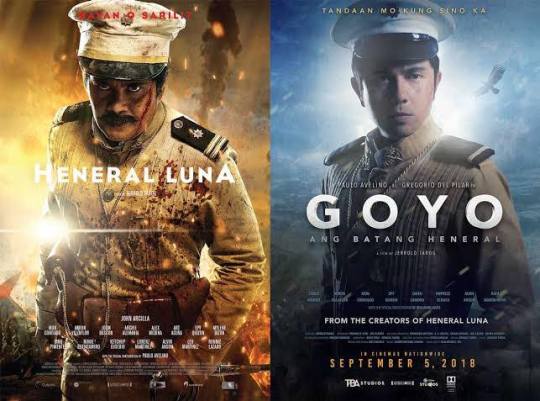
This blog is for the review of the movies: Heneral Luna and Goyo: Ang Batang Heneral. In which, both are masterpieces by Mr. Jerrold Tarog—he is the director of both films and many other films for the Filipinos, which then the masses loved.
The cast of both movies–John Arcilla as Antonio “Heneral Luna” Luna, Paulo Avelino as Gregorio “Goyong/Ang Agila” H. Del Pilar, Mon Confiado as Emilio “Miong” Aguinaldo, Arron Villaflor as Joven Hernando (fictional character for both movies), and Jeffrey Quizon as Apolinario “Ang Utak ng Rebolusyon” Mabini; these characters played significant roles in both films and sparked the revolution for the Filipinos way back after the Three hundred and thirty-three (333) years of Spanish Colonization.
The movie has struck my mind wherein my high hopes were met, especially on Heneral Luna. Its veteran cast and story caught my attention, for I am not a bookworm who spends hours of learning through books. I prefer gaining knowledge through watching clips and listening podcasts, mainly Philippine history. These platforms can give the viewers or listeners a full depiction of what happened in the past rather than text in a book.
Both films are in-line with each other as Heneral Luna's movie took a break first and followed by Goyo: Ang Batang Heneral. The plot of the motion picture for Heneral Luna—the Spanish colonization ended after three hundred and thirty-three (333) grueling years of cruelty, death without exile, rape among women, and no regard for respect for our own country. The Spanish parliament took place in the government. After colonization, Spaniards did not want to surrender to the Filipinos, but instead, they had sold the Philippines to the Americans for twenty million dollars ($20,000,000).
The Filipinos and its parting government unknowingly have issues about their president of that time, who was Emilio Aguinaldo. He became biased on whom to protect and a cowardly reckless leader. The movie showed that the officials were having arguments in meetings and were undecided if they should let the Americans enter. Besides, perceiving if they should let them take place in our government. Felipe Buencamino and Pedro Paterno were some of the Filipino Ilustrados. (in the Spanish era, they were the enlightened or the educated ones; included in the Ilustrados is the Hero of the Philippines, Dr. Jose Rizal) argued that the Americans are here to protectorate the Philippines, and us.
Buencamino and Paterno told the cabinet that Filipinos should look at Americans as allies. However, this argument made Luna and his co-leader Jose Alejandrino, the military leaders for the said meeting, had an outrage. They argued back that it was for the betterment of the country to continue its independence and the revolution. Also, not to waste what our predecessors fought for–to gain independence. At the end of the meeting, one of the guards told the President and Apolinario Mabini that the Americans had already stepped foot. General Luna asked the cabinet to authorize the strike upon the Americans, as early as they can, before letting them have the advantage of more troops than ours.
Mabini warned the cabinet that there were other 7,000 ground troops for the Americans that were on their way in the Philippines. Both generals wanted to strike immediately, wished the soldiers to be ready and to sacrifice for the combat. President Aguinaldo sent Buencamino and Arguelles to handle the debate. He assured the cabinet that Americans would keep peace and order to fight and win against the Spaniards.
On the 13th of August, in the year 1898, the Spanish and American generals discreetly planned a land engagement to turn over control of Intramuros. The incident dragged a new war for General Luna and the Philippines. Buencamino and Paterno showed support for the protection of the United States to the Philippines, which meant that the Philippines would be under the sovereign of the United States of America. Being enraged by their actions, Antonio Luna had a requisition of the traitors (Buencamino and Paterno) of the constitution they swore to support it.
Next, Luna inquired for his resignation as the general, knowing that the traitors were free. Aguinaldo declined the file of the departure of Antonio Luna as he saw him as the only one who was capable of winning the fight. Aguinaldo had approved the General’s appeal on moving the Philippine military headquarters up north.
Later, Luna received a letter from the president, stating that the president paged him in his headquarters in Cabanatuan. Although suspicious, he went to Cabanatuan with pride and honor on his shoulders, having Roman and Rusca upon him. Arriving at Cabanatuan, most of the streets were empty, and the soldiers already left in the morning. Few soldiers remained, mostly from the battalion of Kawit. As Luna went up to the office of the President, he saw only senator Buencamino relaxingly sitting on the President’s chair. While anticipating the general’s arrival, they exchanged heated words with one another. Then, a single shot’s sound reached the office. Upon Antonio Luna’s investigation, he encountered Captain Janolino, who he jailed him up, weeks after the start of the commotion between the American soldiers and Philippine battalion. Wherein, Captain Janolino did not follow the General’s orders. These men from the Kawit battalion shot, stabbed and hacked General Antonio Luna to death. On the other hand, Roman died as well, while Rusca had surrendered to the Kawit soldiers.
At the end of the Heneral Luna movie, it said that the Philippines blamed Aguinaldo for Antonio Luna’s death. However, Aguinaldo denied and gave the general an excellent reputation for him and calls him the most brilliant and capable general. On the other hand, at the same table that the president sat were MacArthur and Otis, who were giving Luna an acknowledgment as a worthy antagonist. They laughed at the Filipinos that they killed the only real general they had.
After that, the President’s favorite–General Gregorio del Pilar or better known as Goyong/Goyo is the next in line to the late, General Antonio Luna, to the sequel movie entitled as Goyo: Ang Batang Heneral.
The movie started in a phase, where the new General had so many rumors about his love life. Through all provinces that he and his men and went to, there would be women that found his handsomeness intriguing. Additionally, there would be a lady that would get in a relationship within every province. If not, he would court to make the lady fall in love, but does not have the intention to have a relationship.
After, General Antonio Luna’s death the next five months had been quiet for the Filipino soldiers—they became relaxed, having a thought of the American’s had stopped the war—afterward, Goyong and his men had captured Manuel Bernal and his little brother, who was included in General Luna’s men, and they are brutally asking him that he should join the force and help on the revolution against the American’s.
Meanwhile, Joven Hernando—now works for his uncle who is Goyong’s assigned photographer; on the other hand, whilst the Filipino army are laid-back, because of the silence of the combat between two forces—the allied forces from the American’s are formulating the second attack Luna’s comrade, Jose Alejandrino, who is saved from the extermination, now meets Apolinario Mabini—who had resigned from President Aguinaldo’s administration afterward the death of Antonio Luna. Pule, then plead Jose Alejandrino to identify the true source of Luna’s annihilation. In addition, Emilio Aguinaldo adjoined General del Pilar at Bulacan—to promote him as the Major-General of Pangasinan, at this time Goyong is beginning to address his love for Remedios—who is the daughter of Don Mariano that has the reputation of being elusive among all to the man who tried to court her. In the next scene, the President met Apolinario to offer him to be the Chief of Justice, in which Pule hesitantly accepts.
General Alejandrino then arrives at Manila to have a negotiation with General Arthur MacArthur Jr. and General Elwell Otis, who had rejected the Filipino General’s request to have peace and order; later then, the animosity continues, and still the Filipinos are off-guard. Aguinaldo then mandated the army to move to Pozorrubio, Pangasinan to have a bigger and stronger army against the surging American soldiers to claim the Philippines at the same time meet General Manuel Tinio for his soldiers to join fellow men on war. Yet, with the President’s request, Tinio and his company had been defeated by the Americans and caused Emilio Aguinaldo to push further north with his family and the army to retreat. The backbreaking march that escorts the President and his family through the mountainous region of Cordillera, the growing tensions between the Kawit soldiers and the late General Luna’s army, the day-to-day intrusion by the American soldiers had made the Army’s defenses fail, to which the mother and the son of Aguinaldo had been captured.
When the squad had reached Mount Tirad in Ilocos Sur, the Major-General had devised a plan to delay the Americans on capturing the President. Collectively with the former sharpshooter of Antonio Luna—Lieutenant Garcia, had reinforced the trenches that were dug along the direction of the mountain. The succeeding day, the American infantry had reached the town at the foot of the mountain, however they cannot infiltrate through the defenses placed by the Philippine soldiers; but through their native guide, the soldiers from America that are under Major Peyton March, had found a path that leads to the top of the mountain, without letting the Filipino soldiers know that they are coming; with this path the Filipinos are then overruled by the American soldiers. The Filipino Major-General then went to the far side of the mountain where he could see the beauty of the mountains, where he resolved to finish the fight against the Americans and surrender, nevertheless he was shot by an American sniper and died. To this result, the spirit of the Philippine allies had broken down and surrendered, while the President fled. Joven and Kiko—Lieutenant Garcia’s son, fled as well, but Joven fell to a cliff in an encounter with an American soldier.
The Americans then had captured the President on 23rd of March, 1901, which basically ended the war. Apolinario Mabini was then captured and was exiled to Guam, where he had written a narrative of his, named “La Revolucion Filipina”—through his writings, he appointed the former President, Emilio Aguinaldo’s failure as an effective leader of the Philippines. Then Remedios received a letter from Goyo.
First and foremost, I liked the star-studded cast of both movies—in which, it is shown that the directors and the writers had thought and planned both movies very well; the plot and the setting of the movies are organized as well, the movie techniques are on point, and it is as if that the viewers are into the place and the chosen kinds of music for both movies are nicely thought of—especially on Goyo: Ang Batang Heneral’s movie, where the “Millenials” are aware of the music from Ben and Ben Band, lastly the I loved how they depicted the movie inlined with the Philippine history to let the generation today learn on how Filipinos had fought against the Americans and the antiquity for how we are today.
I did not like that there are parts that are incomplete if it is compared to the written stories from the past, as well as, there are screen times on how they depicted wrongly about the past.
“May mas malaki tayong kalaban sa mga Amerikano—ang ating mga sarili”, by General Antonio Luna, these words had struck me for they had not seen the truth that the Filipinos are in deep problem with their administration to which had the Filipinos sacrificed their own lives, only knowing that they have a cruel and mindless government; “Walang naka-aangat sa batas—kahit pa ang Presidente”, the words from General Luna proves that the President has an ineffective way on ruling and running the Philippine government; from Joven Hernando—”Ano ba ang halaga ng isang bayani? Bakit tayo pirming naka tingala at sumasamba anng walang pag dududa?”, he implied that the Filipinos in a way are a bunch of children that give full credits to the heroes of war and not thinking if they had done something wrong for us; “Pag bumagsak si Aguinaldo, may bagong titindig. Pero ito—hindi ito mapapalitan.”, even though we are fighting against our own race, we should not leave the lands we own of, we should take care of themand keep them untouched; “Bumigo ang rebolusyon dahil mali ang pamumuno nito”, it shows how the cabinet of the President is unwell and there are a ton of misconceptions on how they are ruling the Philippine government and that is basically why we lost the revolution to the Americans.
In conclusion, no matter what and how the past is depicting us as Filipinos, we should not fully embrace it and live a new life, nevertheless, it should not give us the idea of forgetting the past and how our ancestors have fought for our freedom and lands.

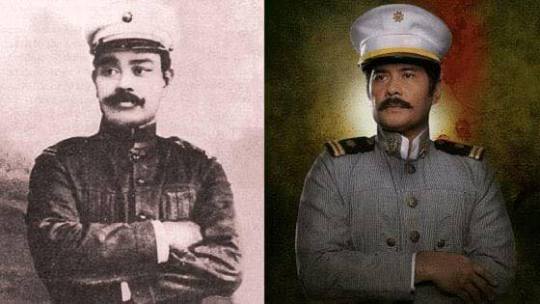


Sources
Netflix
https://www.pinterest.ph/pin/574983077404647285/?lp=true
https://www.spot.ph/entertainment/movies-music-tv/63720/10-quotable-quotes-heneral-luna
https://medium.com/@letzky/takeaways-on-goyo-ang-batang-heneral-6d12014d2341
https://www.wheninmanila.com/goyo-ang-batang-heneral-which-scenes-are-fact-or-fiction/
https://filipiknow.net/facts-about-heneral-luna-movie/
2 notes
·
View notes
Photo
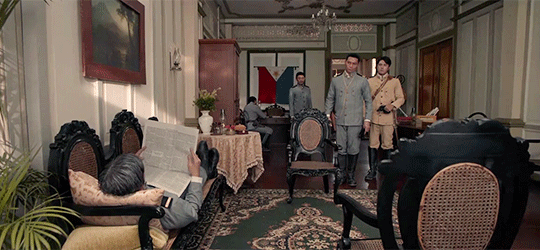

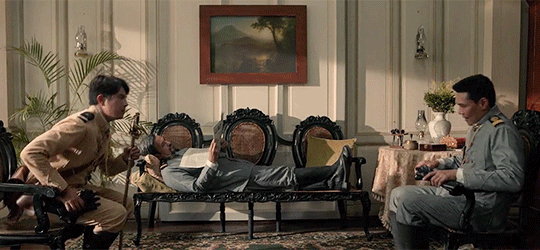
Amin na ang dyaryo.
#akin#jose alejandrino#emilio aguinaldo#gregorio del pilar#goyo: ang batang heneral#goyo2018#heneral goon#heneral moon#bayaniserye#ninong#JOSE KING OF SASS ALEJANDRINO
62 notes
·
View notes